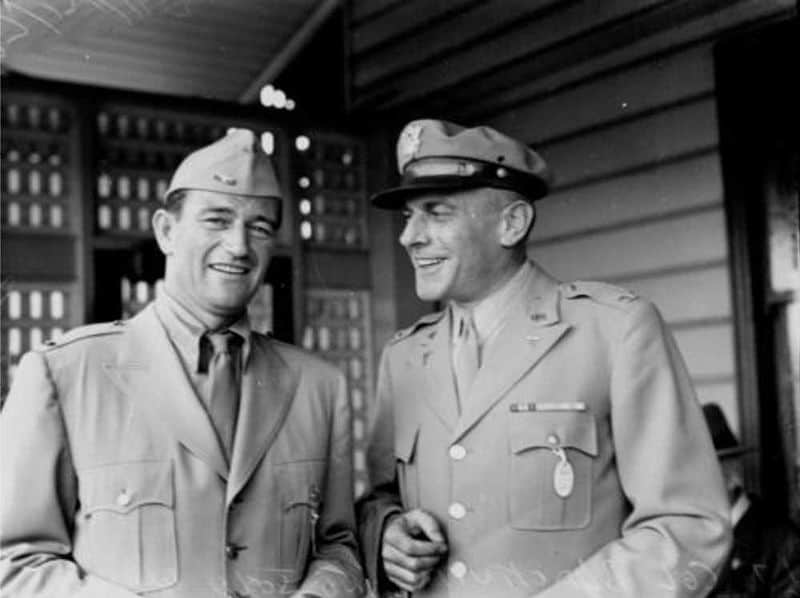A commonly heard critique about John Wayne’s acting is that throughout his more than fifty year acting career he consistently portrayed himself. The man known as the Duke played fictional characters from all walks of life, in a wide variety of professions including soldiers and sailors, cops and robbers, saints and sinners, ranchers, marshal’s, athlete’s, frontiersmen, and even a singing cowboy (with overdubbed voice). Wayne appeared in westerns, dramas, war films, comedies, mysteries, and biblical epics. In addition to his film career as an actor, he was a producer of films, some of which he appeared in and some he didn’t.
Besides appearing as fictional characters, some of whom were loosely based on real personages, John Wayne portrayed several real persons of history, and not all of them American. His roles included a Roman centurion mentioned in the Gospels, and a Mongol warrior. He also played an American businessman and Consul General to Japan and a Civil War general (whom he also played on television). Other real life characters included an influential naval aviator who developed the concept of jeep carriers in the Second World War, a rancher involved in the Lincoln County War, and a commander of US paratroopers who dropped into France during Operation Overlord.

Here are ten real life persons portrayed in film by John Wayne, including what he got right and what he got wrong.

Frank “Spig” Wead. The Wings of Eagles
John Wayne played the role of Frank Wead in the 1957 release The Wings of Eagles, a title taken from the Book of Isaiah (40:31). Wead was one of the earliest US Naval aviators, heavily involved in the development of the branch during its fledgling days, when it competed with the US Army for dollars by establishing flight records for publicity. The film depicts parts of the rivalry in farcical scenes, including the cliché of rivals becoming fast friends after semi-drunken fisticuffs. Wead later became a writer, and wrote several books, plays, magazine articles, and motion pictures scripts, including They Were Expendable, which starred John Wayne and Robert Montgomery.
Wead’s naval career was interrupted due to a fall in his home, accurately played by Wayne in the film. Wead was at home one night when the cries of his daughter caused him to rush to her room, and he either tripped or slipped down a flight of stairs. Paralyzed from the waist down, he underwent a long convalescence, being medically discharged from the Navy in May 1928. The film also accurately depicts Wead’s separations from his wife, which severely strained his marriage, from the dedication to his career before his injury.
Wead died ten years before the film was made, but Wayne knew him from their working together during the making of They Were Expendable. Thus his portrayal was based on first-hand knowledge of Wead’s story. The scenes of Wead’s struggles as a writer and his difficulties coping with his limited ability to walk, with supporting canes, were based on conversations with Wead. When Wead returned to active naval service during World War II, in carriers, Wayne demonstrated how hard it was to move about ship, especially in action under enemy attack. Wead served the final months of his naval career in action against the Japanese in the Pacific.
It is in the combat scenes at sea where the film takes its biggest step from the truth. Newsreel footage used in the film implies that USS Hornet (CV-8) was sunk by the attacks of kamikazes. Hornet was heavily damaged by dive bombers and Japanese torpedo planes (though one Japanese bomber did crash into it) in the Solomon Islands in 1942. The crew abandoned ship and US destroyers tried to sink the carrier, which refused to do down. Finally Japanese destroyers sank the ship. The term kamikaze and their use as a weapon against American ships did not surface until 1944. Timelines in the film were similarly altered with dramatic license.
Those who had known Frank Wead found the Duke’s portrayal of him to be true to the subject, although those who knew Wead best, his wife and children, never commented on his performance publicly. The film was directed by John Ford (who appears as the character John Dodge in the film, played by Ward Bond) and was meant to be a tribute to the screenwriter with whom he had frequently collaborated. Wayne is almost subdued through most of the film, once he is past the part when he is playing a young hellion of a test pilot. The film found little audience when released, lost money, and the story of Frank Wead as a naval officer and film writer remains relatively obscure.

